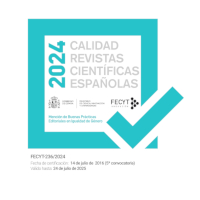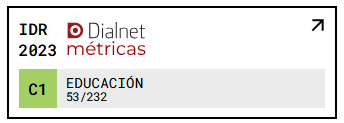Question as a tool for reading stories
DOI:
https://doi.org/10.18172/con.1287Keywords:
Questions, teaching methods, information ways, story readings, discussionAbstract
This article discusses the use of requests for information or questions, in a process of discussion that four teachers conducted with students from the reading of three stories. The sample consists of two classrooms in two public schools in the city of Burgos (Spain), and two more in Tampico (Mexico). In each class we have observed six focus groups composed of three children. To do this, we propose an exploratory study based on systematic observation. First, it produces a qualitative description of teaching sequences showing examples of process questions, to finish analyzing and comparing quantitatively the evolution of the use of questions. Knowledge of responsiveness that has the child helps the teacher to decide what kind of support they need in understanding the narrative. The results suggest that the variety in the types of questions facilitates the recovery and processing of speech in children. This study is an exploratory design, was used as comparison and control groups.Downloads
References
ALBANESE, O. y ANTONIOTTI, C. (1992). The influence of an educator´s interactive style on the process of comprenhension in preschool age children. En Wolters y Schnotz (Eds.), Text comprehension and learning 5, 201-209. Amsterdam.
ALBANESE, O. y ANTONIOTTI, C. (1997). Teacher Dialogue Style and Children's Story Comprehension. European Journal of Psychology of Education 12(3), 249-59.
ANGUERA, T. (1992). Metodología de la observación en ciencias humanas. Madrid. Cátedra.
BAKEMAN, C. y GOTTMAN, R. (1992). Observación de la interacción: introducción al análisis secuencial. Madrid. Cátedra.
BARBIERI, M. S., DEVESCOVI, A. y BONARDI, P. A. (1987). Línterazione verbale tra bambino ed educatrice durante il racconto di una storia. En S. Mantovani y T. Musatti (Eds.) Adulti e bambini. Educare e Comunicare. Roma. Juvenalia.
BORZONE, A. y ROSEMBERG, C. (1994). El intercambio verbal en el aula: las intervenciones de los niños en relación con el estilo de interacción del maestro. Infancia y aprendizaje 67-68, 115-132.
BORZONE, A. (2005). La Lectura de Cuentos en el Jardín Infantil: Un Medio Para el Desarrollo de Estrategias Cognitivas y Lingüísticas. Psykhe 14(1), 192-209.
BRUNER, J. (1986). El habla del niño: aprendiendo a usar el lenguaje. Barcelona. Paidós.
BRUNER, J. (1997). La educación, puerta de la cultura. Madrid. Aprendizaje Visor.
DÍEZ, C., PARDO, P., LARA, F., ANULA, J. J. y GÓNZALEZ, L. (1999). La interacción en el inicio de la lectoescritura. Madrid: CIDE. Ministerio de Educación y Cultura.
DIEZ VEGAS, C. y PARDO DE LEÓN, P. (2000). El trabajo en grupo en el inicio de la escritura. UNED. Madrid. Fundación Universidad-Empresa.
DÍEZ VEGAS, C. (2002) La interacción social y la construcción del conocimiento en el inicio lectoescritor. Un estudio longitudinal. Tesis doctoral. Madrid. Universidad Nacional de Educación a Distancia.
EDWARDS, D. y MERCER, N. (1988). El conocimiento compartido. Madrid. Paidós y MEC.
FRESQUET, A. (2004). La pregunta como instrumento. Fundamentos de la diversificación curricular. El Boletín Semanal de la Asociación Mundial de Educadores Infantiles, 191.
GONZÁLEZ GARCÍA, J. (2006). Elaboración conjunta de inferencias a partir de cuentos infantiles. Psicología Educativa, 12(2), 67-89.
GONZÁLEZ GARCÍA, J. (2007). ¿Qué sabemos de las narraciones como construcción social? Investigación en la Escuela, 62(2), 79-98.
GONZÁLEZ GARCÍA, J. (2008). Debates en el aula de Preescolar a partir de cuentos: Estudio comparado en España y México. Perfiles educativos 29, 118, 54-78.
GONZÁLEZ GARCÍA, J. (2009). Question like instrument of reading story. International Journal of Hispanic Psychology 4, 38-53.
GONZÁLEZ GARCÍA, J. (2010). La puesta en discusión de narraciones infantiles. Estudio comparado en España y México. Educación XXI, 35(1), 141-59.
GONZÁLEZ GARCÍA, J. (2011). Desarrollo de la identidad a partir de experiencias narrativas. Revista Iberoamericana de Educación 54(5).
GONZÁLEZ GARCÍA, J. (2012). El maestro que aprende: más allá de teorías implícitas. La coherencia entre objetivos y estilos educativos. Apuntes de Psicología, 30(1), 5-22.
MERCER, N. (1997). La construcción guiada del conocimiento. Madrid. Paidós.
ORSOLINI, M. y PONTECORVO, C. (1986). Disputare e construire. Processi di conoscenza nell’interazione verbale tra bambini. Età evolutiva, 30, 63-76.
ORSOLINI, M., PONTECORVO, C. y AMONI, M. (1989). Discutere a scuola: interazione sociale e attività cognitiva. Giornale italiano di Psicología XVI, 3.
PONTECORVO, C. (1987). Discussing for reasoning: the role of argument in knowledge construction. En E. De Corte, J. Lodewijks, R. Parmentier y P. Span (Eds.). Learning and Instruction. European research in an international context, 1-82. Leuven: Leuven University Press.
PONTECORVO, C. y ORSOLINI, M. (1992). Analizando los discursos de las prácticas alfabetizadoras desde la perspectiva de la actividad. Infancia y Aprendizaje 58, 125-141.
RODARI, G. (2000). Grámatica de la fantasía. Introducción al arte de inventar cuentos. Buenos Aires. Colihue/ Biblioser.
ROGOFF, B. (1993). Aprendices del pensamiento. Barcelona. Paidós.
SÁTIRO, A. y DE PUIG, I. (2000). Jugar a pensar. Recursos para aprender a pensar en educación infantil. Barcelona. Eumo-Octaedro.
SIGNES, C. (2004). Jugando a pensar. Una experiencia en educación infantil. Creamundos. Disponible en: http://personal.telefonica.terra.es/web/crearmundos/.
WELLS, G. (1999). Dialogic Inquiry. London. Cambridge University Press.
Downloads
Published
How to Cite
Issue
Section
License
The authors retain copyright of articles and authorize Contextos Educativos. Revista de Educación the first publication. They are free to share and redistribute the article without obtaining permission from the publisher as long as they give appropriate credit to the editor and the journal.
Self-archiving is allowed too. In fact, it is recommendable to deposit a PDF version of the paper in academic and/or institutional repositories.












